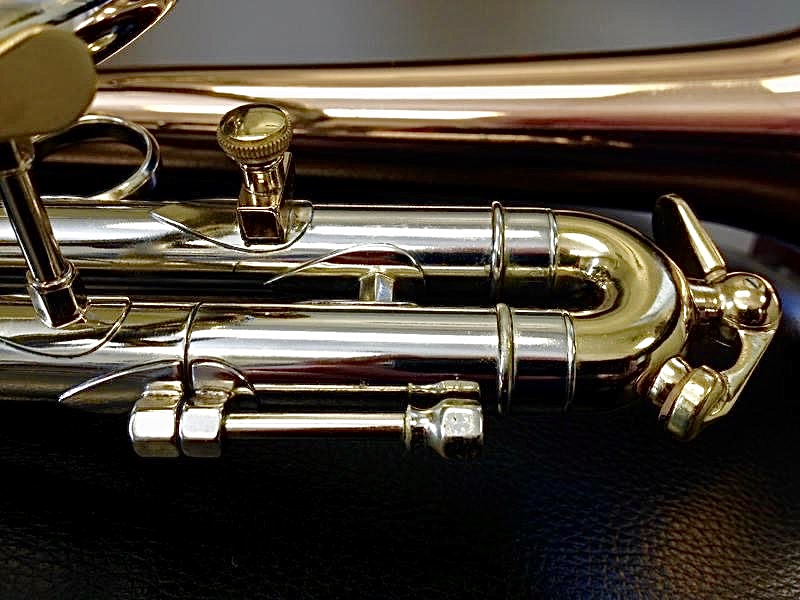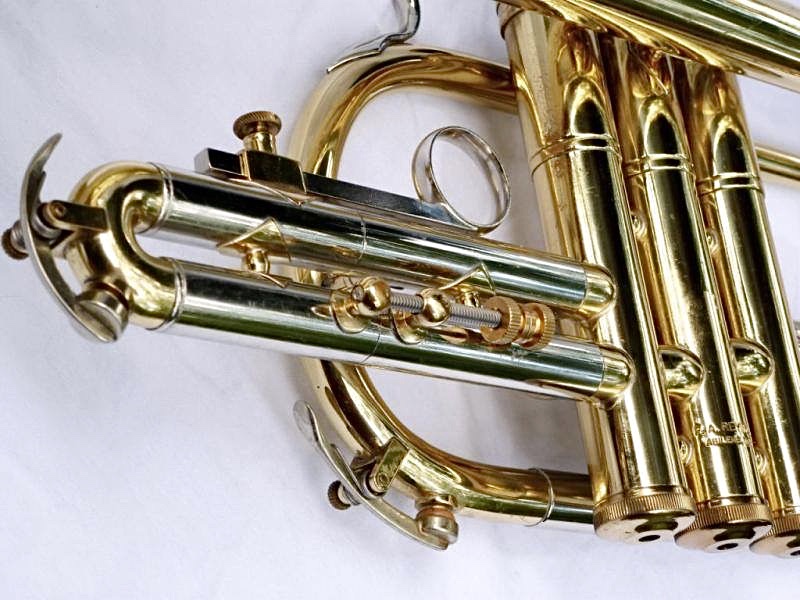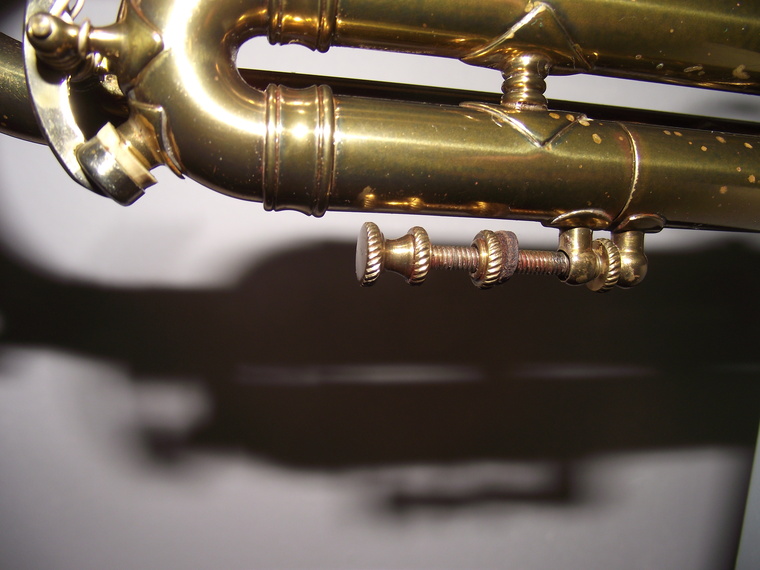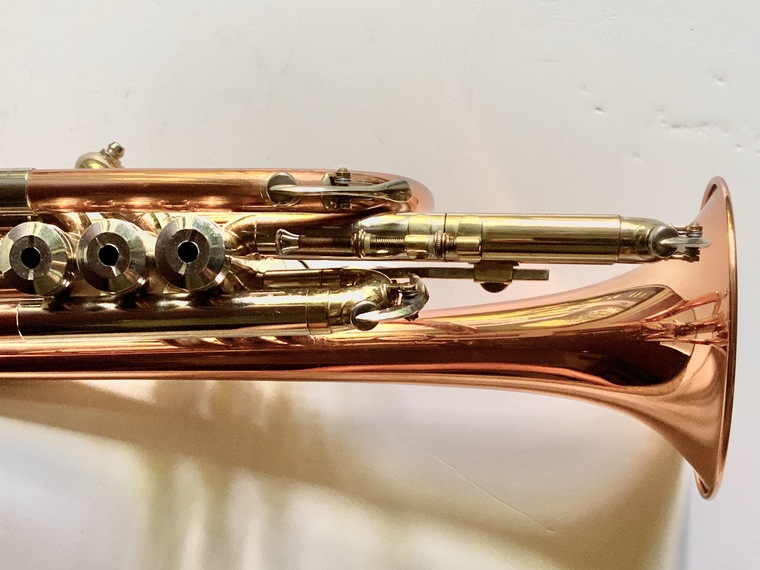40's Holton info
-
Looking for information on specs for a mid to late 40's Holton Revelation 3rd slide stop rod and hardware. Any info would be welcomed, ie; thread size would be of help..available replacement parts ?
I remember reading on TM something about Bach parts fitting or not. Can't remember much, as I wasn't much into Holton back then.
Tried a Bach rod into it but seemed loose. Any helpers?G.
-
The stop rod on third slides of post-war Holtons is not a stop rod, but a stop screw - horizontally mounted (not the sort we think of today). Those screws are 5-40s and thread into the far post with typically a large head cast on the screw. In the 1940s, these could be a length of threaded rod with an end-nut firmly threaded on rather than a cap formed, and typically also had one nut and two bumper discs included.
http://www.trumpet-history.com/Virtual Museum_files/image173.jpg (example is actually 1939, with a cast head on the screw)By the 1950s, the adjustable nut went away and the cap end was always part of the screw.
http://www.trumpet-history.com/Virtual Museum_files/image186.jpg5-40 is the same thread as Bach stop-rods and nuts, however the end of the Bach part that is secured into the post is different - which is why it wont work.
I have found that 5-40 stainless allen cap screws make a functional, if not quite as aesthetic, substitute for these.
http://www.trumpet-history.com/Virtual Museum_files/newpic018.JPG -
Here’s a picture of one on a 1960s model Holton cornet.

As OSE said, you can make a functioning one from a long stainless steel screw from the hardware store. I did that for an old Reynolds cornet that was missing one.

-
Thank to you both for the info. I do have an original ste up on a '47 Revelation...but nothing to measure with really. For the time being, I used a gold Strad rod(backwards) and nuts, althow, the strad theded rod seems a bit loose. I used a bit of teflon tape to make up the gap...on the knob end, I was looking for something a bit closer to the original, and find the Strad nuts a bit massive...may opt for a NY Strad (early) style end cap soldered to the end(discarded the unthreaded end)...or a salvaged old clock knob...at least for the time being I have something to keep the slide from falling off.
Dale; thank's for the photos, I do have 2 of those nickel ones on a model 47 and a 51lb, but really wanted something special for the 45! It will take a couple weeks, but, I'll try to post a photo when I'm done
G
-
What I have to work with, note, there where 2 gaskets, they are leather, don't know if they are originally suplied on this..one disingrated in the initial bath. Also I assume I reinstall one nut in the wrong place, but it was to keep the screw tight.

-
As for the trumpet-history site...I must say that it if by far the best site to see and learn about Holton trumpets and cornets..
Good job!Guy
-
@tptguy said in 40's Holton info:
What I have to work with, note, there where 2 gaskets, they are leather, don't know if they are originally suplied on this..one disingrated in the initial bath. Also I assume I reinstall one nut in the wrong place, but it was to keep the screw tight.

That reminds me a little of the old Conn stop rod setup. One bumper to cushion the throw and another to cushion the return.

-
@tptguy said in 40's Holton info:
What I have to work with, note, there where 2 gaskets, they are leather, don't know if they are originally suplied on this..one disingrated in the initial bath. Also I assume I reinstall one nut in the wrong place, but it was to keep the screw tight.

On a 30s/early 40s set-up like that one cushion goes where you have one of the locking nuts, the other as you have it. These came with two. If you have a worn out belt or pair of shoes with leather, you can make replacements (or substitute a modern plastic washer). The two nuts are a locking pair - though it is exceedingly rare to come across a Holton with both still there (I have just one - wasn't sure if it was a mistake or a complete set). I have wondered if many came without the second one for locking ....
The length was so short on these I think most people just took out the nuts and washers to get the full length throw and that then led to Holton eliminating those in the 50's screw design.
Blue loctite can work wonders with worn threads, a little heat will break it loose if ever necessary - BUT DONT EVER USE RED!
BTW: I had a bag of those Conn end nuts like the one in Dale's latest pic - they turned out to be 5-40!
-
@OldSchoolEuph I actually have a second complete ste that I never realised I had...go figure! minus the leather washers, so cool though. Looking to fashion a couple more for 2 other 40's Holtons. As for lenght, I find them as short as 30's Strads, with the nuts on the front side...maybe less correction was required back then?
Still like teflon tape on the threads, don't want to use heat to get slides out for the cleaning procedures.
I'll post photos of whatever I come up with.
Thank you to all.G.
-
@tptguy Oldschool...
I ame using a Strad. rod with som snall hex nuts(NY Strad style, but smaller ) that a good buddy made special for me, the rod from Strads fit perfect on the holton and look to be the same 5-40 thread, also fits all my Holtons.... I think the Conn set ups are 6-32 or 6-36 thread, my 2 cents
-
@tptguy said in 40's Holton info:
@tptguy Oldschool...
I ame using a Strad. rod with som snall hex nuts(NY Strad style, but smaller ) that a good buddy made special for me, the rod from Strads fit perfect on the holton and look to be the same 5-40 thread, also fits all my Holtons.... I think the Conn set ups are 6-32 or 6-36 thread, my 2 cents
Yes, most Conns I have seen are a larger thread - Connstellation nut sets that I have bought on EBay though were 5-40 and looked just like that (maybe the Chinese supplier got it wrong - haven't actually tried them on a Conn)
-
@oldschooleuph Mostly looking for Revelation 45 stuff. Form I understand from the Trumpet- History site' the bell numbers ( at least early 40's to mid 50's) where actually references to the leadpipes and not the bells themselves. So are the bells the same,(same mandrel shape) with different numbers ? My '45 Rev. 45 and '46 Rev. 48 bells have a verry different sound to them when tapped lightly, with the 48 in original gold lacquer( rings like a bell) seems thicker and the 45 in raw brass( sounds more like a garbage can lid) feels lighter and thinner.
That said, even with all it's issues, the Rev.45 sounds great, crisp and bright, not far from the brightness of a '50 Olds Studio -
@tptguy said in 40's Holton info:
@oldschooleuph Mostly looking for Revelation 45 stuff. Form I understand from the Trumpet- History site' the bell numbers ( at least early 40's to mid 50's) where actually references to the leadpipes and not the bells themselves. So are the bells the same,(same mandrel shape) with different numbers ? My '45 Rev. 45 and '46 Rev. 48 bells have a verry different sound to them when tapped lightly, with the 48 in original gold lacquer( rings like a bell) seems thicker and the 45 in raw brass( sounds more like a garbage can lid) feels lighter and thinner.
That said, even with all it's issues, the Rev.45 sounds great, crisp and bright, not far from the brightness of a '50 Olds StudioThe bells were similar between the 45s and the 48s, except that the 45 was choked (Per Holton literature of the early 50s). That being said, I have paired 48 bells just a couple years apart that are clearly different. 1940s brass supplies and tolerances made for significant variation horn to horn.
-
@oldschooleuph I Have 2 48 Revelations, one 166xxx and 165xxx, I would say that even only a few months apart , they have a difference in bell material composition. The "newer" one has the original gold lacquer(I think) the older is in raw brass